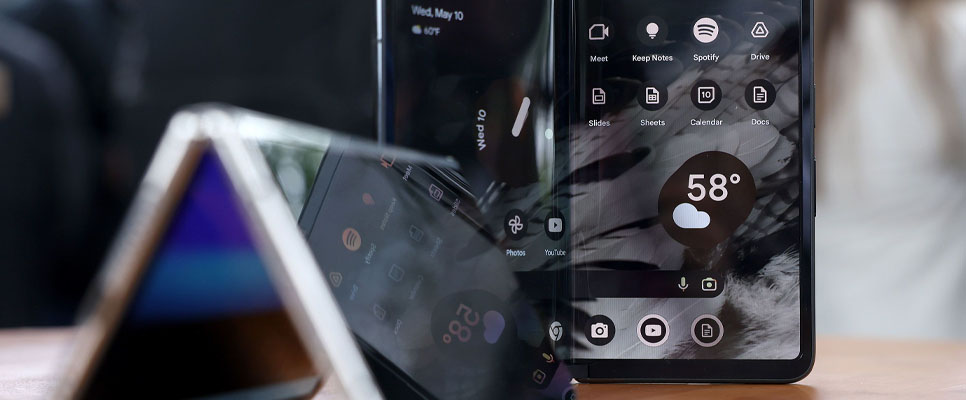
Many people follow trends to stay informed about what’s popular. Foldable phones are arguably one of the most controversial innovations in the world of phone technology, which is quite interesting. Unique features, such as a display that seamlessly transitions between a tablet and a smartphone, capture attention, but do they offer any value? Do they even have a sustainable future? This blog aims to help you build an informed opinion by reviewing key factors, including emerging demand, unique selling propositions, drawbacks, and opportunities for new technologies and trends.
1. From Evolution to Revolution: The History of Mobile Phone Designs
Diagrams of the first generation of phones show that all smartphone designs used to look identical —an interface with a singular touchscreen rectangle. Throughout history, the size and complexity of interfaces have increased, but the fundamental design principles have remained essentially unchanged. Users had to cope with the bulk of mobile phones until the need to multitask became more prevalent. Foldable telephones came to the rescue. These phones are compact when folded, but when opened, they are substantial. This modern design has revolutionised the concept of smartphones, making foldables a serious competitor to traditional smartphones.
2. Main Reasons Contributing To The Increase In Popularity Of Foldable Phones
Foldable phones allow users to experience a tablet-like functionality. Activities involving gaming or watching media are possible on a big screen, and the device is easily transportable when folded. Our device is pocketable, convenient, and when unfolded, provides an even larger screen for productivity and entertainment. No one wants to be left behind in the technology craze, and foldable phones offer users new excitement in the form of different smartphone structures. The new bending styles and a flexible display’s peculiar bending grip draw attention. The initial foldable phones were not very durable, but manufacturers have now addressed these issues. Newer models of foldables have upgraded parts, including stronger hinges, better screen protection, and dust and water resistance in some brands. These contrast with older models, and the enhancements make the phones more suitable for daily use.
As users gain access to more devices, developers focus on updating the software to enhance the user experience when interacting with various apps across different screen sizes and orientations. Features such as app folding and unfolding modifiers, as well as enhanced multitasking capabilities, contribute to user satisfaction and ease.
3. Challenges Facing Foldable Phones
Although prices are dropping, foldable phones still cost more than flagship smartphones. The sophisticated technology and more advanced features still make it a luxury for most consumers. Despite advancements, foldable screens remain more susceptible to scratches and damage than glass displays. There is some degree of wear and tear on the folding mechanism, raising questions about its durability and reliability over time. Due to the folding mechanism, some foldable phones are thicker and heavier than other smartphones, making them less convenient to carry and use, especially when the phone is folded. Not every app is designed to take advantage of a foldable screen, which diminishes the user experience. Far too many apps fail to leverage the larger screen or resize as intended, which is disappointing.
4. The Foldable Smartphones Outlook
With more advanced technology and improved manufacturing methods, foldable devices are expected to become more affordable. These cost-efficient foldables will increase accessibility. In addition to the usual flip and fold shapes, manufacturers are exploring new designs, such as rollable phones (screens that extend sideways) and tri-fold devices (screens that double fold). These changes have the potential to completely transform smartphone design. Gap phones are expected to have stronger hinges, improved battery life, and sleek, lightweight designs. These enhancements will address the shortcomings of current foldables, making them more appealing. Traditional slab-style smartphones are anticipated to be outclassed by foldables, which are set to become the primary gap device as their lifespan extends and costs decrease. Foldables are expected to become the primary gap device as life span increases and costs decrease. Increased competition is expected to bolster innovation and lower costs further.
Foldable phones combine the features of multiple devices into one, serving as a phone and tablet. While they are handy for multitaskers, gamers, and general consumers, there are several ways to improve the devices, including addressing issues with price, software limitations, and fragility. In retrospect, there are some areas that most users aspire to guarantee against harsh durability standards. Patriot enthusiasts may consider the phones useful; however, for avid tech followers, waiting longer till targets become more affordable would be better. The essence lies in the fact that the remaining elements of the device hint at potential growth.